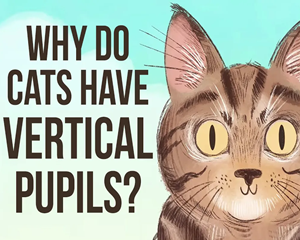Peering into the eyes of different animals, you'll see some extraordinarily shaped pupils. But why?
凝视不同动物的眼睛,你会看到一些形状奇特的瞳孔。但是这是为什么呢?
It turns out that pupil shape is a powerful indicator of what role an animal plays in its ecosystem.
原来,瞳孔的形状可以有力地说明动物在其生态系统中扮演的角色。
Pupils mark the hollow opening in the iris, the eye's band of pigmented muscle.
瞳孔标记虹膜中的空心开口,虹膜是眼睛的色素沉着肌肉带。
They're the portholes through which light enters the eye,
它们是让光线进入眼睛的“舷窗”,
where it then strikes the retina and activates light-sensitive cells, setting the process of vision in motion.
然后它撞击视网膜并激活光敏细胞,使视觉活动起来。
Pupils are black because most of the light that enters them is absorbed.
瞳孔是黑色的,因为进入瞳孔的大部分光线被吸收了。
Their size changes in response to brightness, as well as certain drugs and emotional and mental states -- but their basic form varies greatly among species.
它们的大小会随着亮度而变化,以及某些药物、情绪和精神状态的改变而变化--但它们的基本形态在物种之间差别很大。
House cats, for one, are twilight hunters with vertically elongated pupils.
举个例子,家猫是黄昏猎手,瞳孔垂直拉长。
In the dark, these structures expand dramatically, taking in the available light. When it's bright, they shrink into slits.
在黑暗中,这些结构急剧扩张,吸收可用的光线。天亮时,它们会缩成狭缝。
In fact, cat pupils are so flexible that their maximum area is 135 times greater than their minimum area -- whereas our pupils only shrink and expand 15-fold.
事实上,猫的瞳孔非常灵活,它们的瞳孔最大面积是最小面积的135倍,而我们的瞳孔只能缩小或扩大15倍。
And because of how the slit pupil takes in light, it creates sharp, vertical contours.
由于瞳孔的狭缝吸收光线的方式,它形成了尖锐的垂直轮廓。
When the cat's brain processes the visuals from each eye, the small but sharp differences between them help the cat judge the precise distance of its target.
当猫的大脑处理每只眼睛带来的视觉信息时,它们之间微小但尖锐的差异能帮助猫判断目标的精确距离。
In fact, many other ambush hunters also have vertically elongated pupils -- but mainly those whose eyes are located closer to the ground.
事实上,许多其他的伏击猎者也有垂直伸长的瞳孔--但主要是眼睛离地面更近的那些。
This may be because these pupils are especially useful in perceiving objects at the relative short distances these animals tend to hunt.
这可能是因为这些瞳孔在较短的距离上感知物体特别有用,而这些动物一般近距离捕猎。
The world looks very different from behind the horizontally elongated pupils of many grazing and browsing animals, like goats.
从许多放牧和吃嫩叶的动物的横向拉长瞳孔来看,世界会看起来非常不同,比如山羊。

These pupils, situated on either side of the head, let horizontal bands of light in that give the goat a near-360-degree view and provide it with sharp, horizontal images.
这些位于头部两侧的瞳孔,让水平的光进入,使山羊具有近360度的视野,并提供清晰的水平图像。
This helps goats detect any disruption to the horizon -- alerting them to potential predators
这能帮助山羊探测到地平线上的任何干扰--提醒它们注意潜在的捕食者,
while still enabling them to see ahead and detect obstacles as they make their escape.
同时还能让它们在逃跑时看到前方并探测到障碍物。
In fact, goats always keep their pupils aligned with the horizon, rotating their eyeballs in their sockets as they move their heads up and down.
事实上,山羊总是让它们的瞳孔与地平线保持一致,当它们上下移动头部时,它们的眼球在眼窝里转动。
Meanwhile, nocturnal geckos have pupils that shrink into slits studded with pinholes in higher light conditions.
与此同时,夜间活动的壁虎在较高的光照条件下瞳孔会收缩成布满针孔的狭缝。
Each pinhole projects a separate, sharp image onto the geckos retina.
每个针孔将一个单独的清晰图像投射到壁虎视网膜上。
Scientists think that comparing these different inputs might help the gecko judge distance without having to move.
科学家们认为,比较这些不同的输入信息可能有助于壁虎无需移动就能判断距离。
And while they might have fooled you, mantises and other insects and crustaceans have "pseudopupils."
虽然它们可能愚弄了你,但螳螂和其他昆虫以及甲壳类动物都有“伪瞳孔”。
These aren't optical structures; they're optical illusions experienced by the observer.
这些不是光学结构,而是观察者体验到的视错觉。
Mantises have compound eyes composed of thousands of light-sensing units.
螳螂的复眼由数千个感光单元组成。
When some are aimed at you, they appear black because they're absorbing most wavelengths of incoming light -- but there's no actual opening.
当它们瞄准你的时候,它们看起来是黑色的,因为它们吸收了入射光的大部分波长--但没有实际的开口。
So, why do we have round pupils? Elongated pupils help sharpen certain dimensions of an animal's vision.
那么,为什么我们的瞳孔是圆的呢?细长的瞳孔有助于提高动物视觉的某些维度。
But scientists think that, for animals like us with circular pupils, this is a lower priority.
但科学家们认为,对于像我们这样瞳孔呈圆形的动物来说,这是一个较低的优先级。
Instead of seeing some elements of a scene in extreme focus, we see a larger picture in relative detail, which enables more general skills of observation.
我们看到的不是极端聚焦的场景中的一些元素,而是一个相对细节更大的画面,这使得更一般的观察技能成为可能。
This may be especially helpful for foragers looking for food, hunters eyeballing and chasing their prey, and social animals recognizing other faces.
这可能对寻找食物的觅食者、捕猎者注视和追逐猎物以及社会动物识别其他面孔特别有帮助。
As we peer at different pupils, patterns emerge. And yet there are exceptions.
当我们观察不同的瞳孔时,规律就会浮现出来。但也有例外。
For example, Pallas's cats and mongooses are both small ambush predators, but the Pallas's cat has round pupils and mongooses have goat-like pupils.
例如,帕拉斯猫和猫鼬都是小型伏击捕食者,但帕拉斯猫有圆形的瞳孔,猫鼬有山羊般的瞳孔。
And we've only explored a few pupil shapes. Other animals have crescent -- or heart-shaped pupils.
我们只探索了几种瞳孔形状。其他动物有新月形或心形瞳孔。
And the cuttlefish has perhaps some of the most bizarre: their pupils are circular in the dark, but W-shaped in the light.
或许墨鱼的最奇特:它们的瞳孔在黑暗中是圆形的,但在光线下是W形的。
So, what's going on here? Well, wouldn't we all like to know?
那么,这到底是怎么回事呢?我们应该都想知道吧。













